2018 MERCEDES-BENZ SLC ROADSTER air condition
[x] Cancel search: air conditionPage 28 of 298
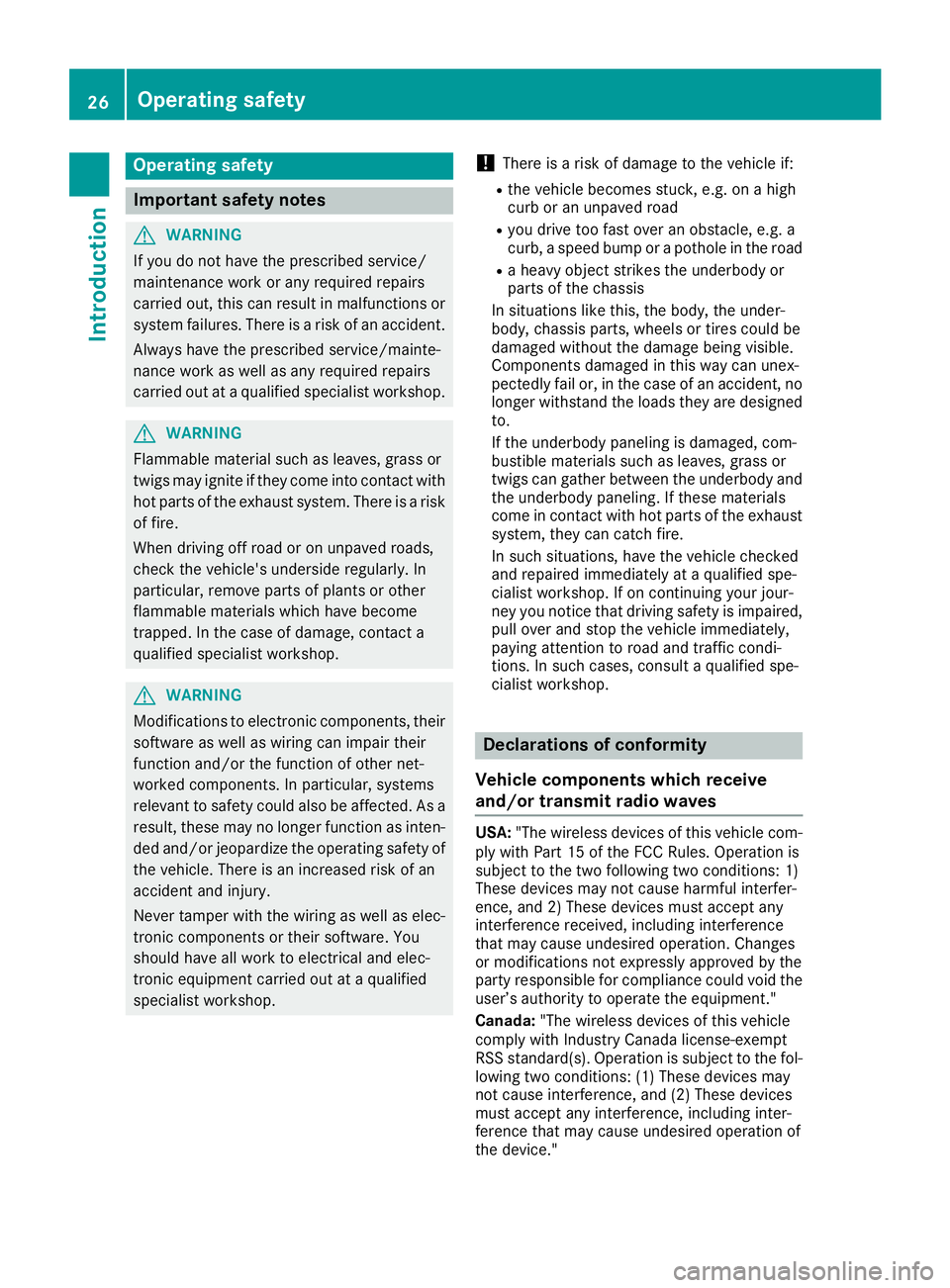
Operating safety
Important safetynotes
GWARNING
If you do not have the prescribed service/
maintenanc ework or any required repairs
carried out, this can result in malfunctions or system failures. There is arisk of an accident.
Always have the prescribed service/mainte-
nanc ework as well as any required repairs
carried out at aqualified specialist workshop.
GWARNING
Flammable material such as leaves, grass or
twigs may ignite if they come into contact with
hot parts of the exhaust system. There is arisk
of fire.
When driving off road or on unpaved roads,
checkt he vehicle's underside regularly. In
particular, remove parts of plants or other
flammable materials which have become
trapped. In the case of damage, contact a
qualified specialist workshop.
GWARNING
Modifications to electronic components, their software as well as wiring can impair their
function and/or the function of other net-
worked components. In particular, systems
relevant to safety could also be affected. As a
result, these may no longer function as inten-
ded and/or jeopardiz ethe operatin gsafety of
the vehicle. There is an increased risk of an
accidenta nd injury.
Never tamper with the wiring as well as elec-
tronic component sortheir software. You
should have all work to electrical and elec-
tronic equipment carried out at aqualified
specialist workshop.
!There is arisk of damage to the vehicle if:
Rthe vehicle becomes stuck ,e.g. on ahigh
curb or an unpaved road
Ryou drive too fast over an obstacle, e.g. a
curb, aspeed bump or apothole in the road
Rah eavy objec tstrikes the underbody or
parts of the chassis
In situation slike this, the body, the under-
body, chassis parts, wheels or tires could be
damaged without the damage being visible.
Components damaged in this way can unex-
pectedly fail or, in the case of an accident, no
longer withstand the loads they are designed
to.
If the underbody paneling is damaged, com-
bustible materials such as leaves, grass or
twigs can gather between the underbody and
the underbody paneling. If these materials
come in contact with hot parts of the exhaust system, they can catc hfire.
In such situations, have the vehicle checked
and repaired immediately at aqualified spe-
cialist workshop. If on continuin gyour jour-
ney you notice that driving safety is impaired,
pull over and stop the vehicle immediately,
paying attention to road and traffic condi-
tions. In such cases, consult aqualified spe-
cialist workshop.
Declarations of conformity
Vehicle components which receive
and/or transmit radio waves
USA: "The wireless devices of this vehicle com-
ply with Part 15 of the FCC Rules. Operation is
subject to the two following two conditions :1)
These devices may not cause harmful interfer-
ence, and 2) These devices must accept any
interference received, including interference
that may cause undesired operation .Changes
or modifications not expressly approved by the
party responsible for compliancec ould void the
user’s authorit ytooperate the equipment."
Canada: "The wireless devices of this vehicle
comply with Industry Canada license-exempt
RSS standard(s). Operation is subject to the fol-
lowing two conditions :(1) These devices may
not cause interference, and (2) These devices
must accept any interference, including inter-
ference that may cause undesired operation of
the device."
26Operating safety
Introduction
Page 30 of 298
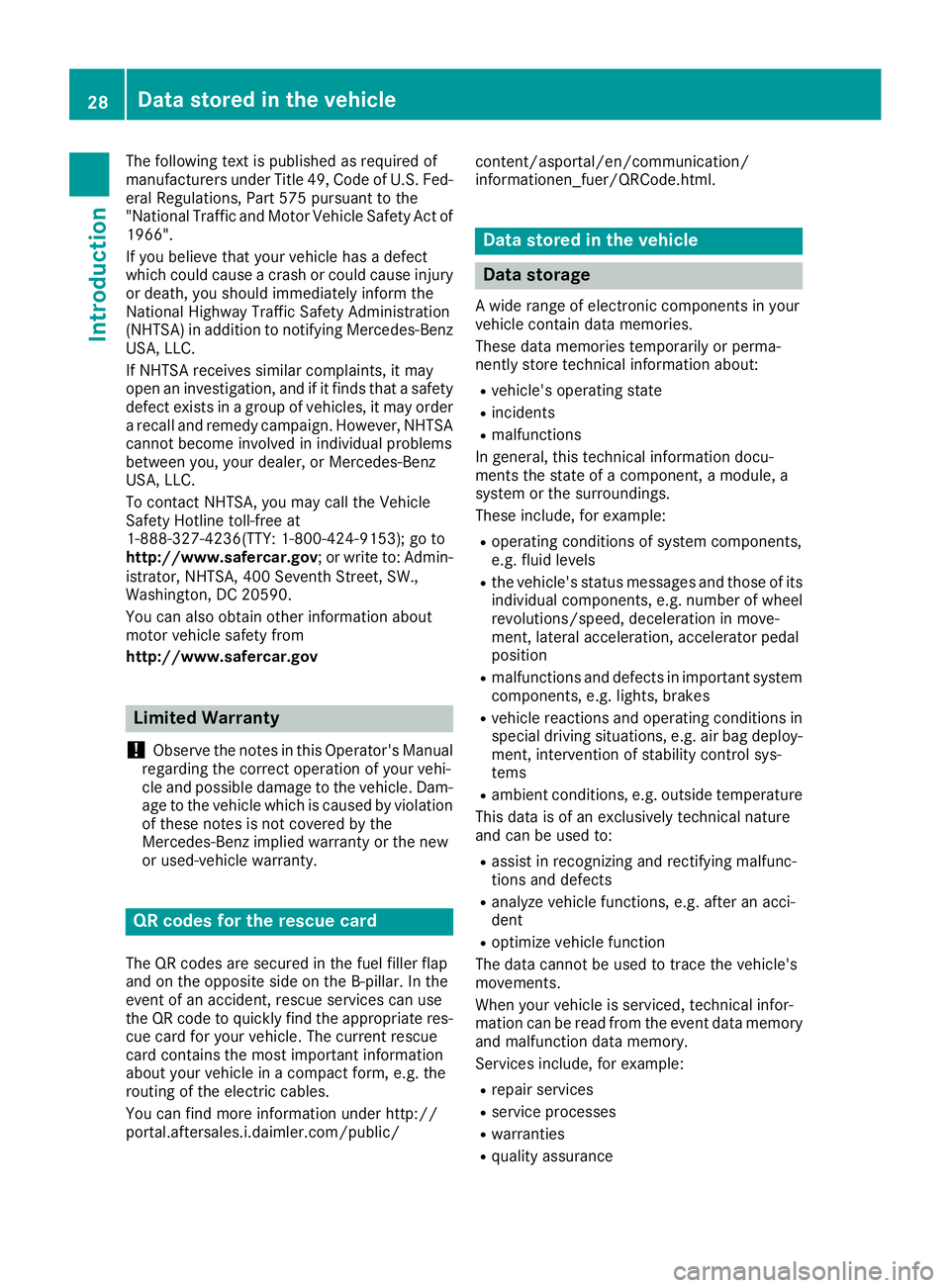
The following text is published as required of
manufacturers under Title 49, Code of U.S. Fed-
eral Regulations, Part 575 pursuant to the
"National Traffic and Motor Vehicle Safety Act of
1966".
If you believe that your vehicle hasadefect
which could cause acrash or could cause injury
or death, you should immediately inform the
National Highway Traffic Safety Administration
(NHTSA)ina ddition to notifying Mercedes-Benz
USA,L LC.
If NHTSA receives similar complaints ,itmay
open an investigation, and if it finds that asafety
defect exists in agroup of vehicles, it may order
ar ecall and remedy campaign. However, NHTSA
cannot become involved in individual problems
between you, your dealer, or Mercedes-Benz
USA,L LC.
To contact NHTSA,y ou may call the Vehicle
Safety Hotlin etoll-free at
1-888-327-4236(TTY: 1-800-424-9153); go to
http://www.safercar.gov ;orwrite to: Admin-
istrator ,NHTSA,4 00 SeventhS treet, SW.,
Washington ,DC20590.
You can also obtain other information about
motor vehicle safety from
http://www.safercar.gov
Limited Warranty
!
Observe the notes in this Operator's Manual
regarding the correcto peration of your vehi-
cle and possible damage to the vehicle. Dam-
age to the vehicle which is caused by violation
of these notes is not covered by the
Mercedes-Benz implied warranty or the new
or used-vehicle warranty.
QR codes for the rescue card
The QR codes are secured in the fuel filler flap
and on the opposite side on the B-pillar. In the
event of an accident,r escue services can use
the QR code to quickly find the appropriate res- cue card for your vehicle. The current rescue
card contains the most important information
about your vehicle in acompact form, e.g. the
routing of the electric cables.
You can find more information under http://
portal.aftersales.i.daimler.com/public/ content/asportal/en/communication/
informationen_fuer/QRCode.html.
Data stored in the vehicle
Data storage
Aw
ide range of electronic components in your
vehicle contain data memories.
These data memories temporarily or perma-
nently store technical information about:
Rvehicle's operating state
Rincidents
Rmalfunctions
In general, this technical information docu-
mentst he state of acomponent, amodule, a
system or the surroundings.
These include, for example:
Roperating conditions of system components,
e.g. fluid levels
Rthe vehicle's status messages and those of its
individual components, e.g. number of wheel
revolutions/speed, deceleration in move-
ment,l ateral acceleration, accelerator pedal
position
Rmalfunction sand defects in important system
components, e.g. lights, brakes
Rvehicle reactionsa nd operating conditions in
special driving situations, e.g. air bag deploy-
ment,i ntervention of stability control sys-
tems
Rambient conditions, e.g. outside temperature
This data is of an exclusively technical nature
and can be used to:
Rassist in recognizing and rectifying malfunc-
tions and defects
Ranalyze vehicle functions, e.g. after an acci-
dent
Roptimize vehicle function
The data cannot be used to trace the vehicle's
movements.
When your vehicle is serviced, technical infor-
mation can be read from the event data memory
and malfunction data memory.
Services include, for example:
Rrepair services
Rservice processes
Rwarranties
Rquality assurance
28Data stored in the vehicle
Introduction
Page 31 of 298

The vehicle is read out by employees of the ser-
vice network (including the manufacturer) using
special diagnostic testers. More detailed infor-
mation is obtained from it, if required.
Afteramalfunction has been rectified, the infor-
mation is deleted from the malfunction memory
or is continually overwritten.
When operating the vehicle, situations are con-
ceivable in which this technical data, in connec-
tion with other information (if necessary, under
consultation with an authorized expert), could
be traced to aperson.
Examples include:
Raccident reports
Rdamage to the vehicle
Rwitness statements
Further additional functions that have been con-
tractually agreed upon with the customer allow
certain vehicle data to be conveyed by the vehi- cle as well. The additional functions include, for
example, vehicle location in case of an emer-
gency.
COMAND/mbrace (Canada: TELEAID)
If the vehicle is equipped with COMAND or
mbrace, additional data about the vehicle's
operation, the use of the vehicle in certain sit-
uations, and the location of the vehicle may be
compiled through COMAND or the mbrace sys-
tem.
For additional information please refer to the
COMAND User Manual or the Digital Operator's Manual and/or the mbrace Terms and Condi-
tions.
Event datar ecorders
This vehicle is equipped with an event data
recorder (EDR). This vehicle is equipped with an
event data recorder (EDR). The main purpose of
an EDRistor ecord, in certain crash or near
crash-lik esituations, such as an air bag deploy-
ment or hittin garoad obstacle, data that will
assist in understanding how avehicle's systems
performed. The ED Risdesigned to record data
related to vehicle dynamics and safety systems
for ashort period of time, typically 30 seconds
or less. The ED
Rinthis vehicle is designed to record
such data as:
RHow various systems in your vehicle were
operating
RWhether or not the driver and passenger
safety belts were buckled/fastened
RHow far (if at all) the driver was depressing the accelerator and/or brake pedal and
RHow fast the vehicle was traveling.
These data can help provide abetter under-
standin gofthe circumstances in which acci-
dents and injuries occur. NOTE: ED Rdata are
recorded by your vehicle only if anon-trivial
crash situation occurs; no data is recorded by
the ED Runder normal driving conditions and no
personal data (e.g. name, gender, age and acci-
dent location) are recorded. However, other par- ties, such as law enforcement could combine
ED Rd ata with the type of personally identifying
data routinely acquired during acrash investi-
gation.
Access to the vehicle and/or the ED Risneeded
to read data that is recorded by the EDR, and
special equipment is required. In addition to the
vehicle manufacturer, other parties that have
the special equipment, such as law enforce-
ment,c an read the information by accessing the
vehicle or the EDR.
ED Rd ata may be used in civil and criminal mat-
ters as atool in accident reconstruction, acci-
dent claims and vehicle safety. Sincet he Crash
Data Retrieval CDR tool that is used to extract
data from the ED Riscommercially available,
Mercedes-Benz USA,L LC ("MBUSA") expressly
disclaims any and all liability arising from the
extraction of this information by unauthorized
Mercedes-Benz personnel.
MBUSA will not share ED Rdata with others
without the consentoft hevehicle owners or, if
t
he vehicle is leased, without the consen tofthe
lessee. Exceptions to this representation
include responses to subpoenas by law enforce- ment;byf ederal, state or local government; in
connection with or arising out of litigation involv-
ing MBUSA or its subsidiaries and affiliates; or,
as required by law.
Warning: The ED Risacomponent of the
Restraint System Module. Tampering with, alter-
ing, modifying or removing the ED Rcomponent
may result in amalfunction of the Restraint Sys-
tem Module and other systems.
Statel aws or regulations regarding EDRs that
conflict with federal regulation are pre-empted.
Data stored in the vehicle29
Introduction
Z
Page 47 of 298

could be adverselyaffected. Thisposes an
increase driskofi njury or evenf atalinjury.
You shoul donly us eseatc overst hat have
bee napproved for the respectiv eseatb y
Mercedes-Benz.
Sid eimpact ai rbags: deploy next to the outer
bolster of the seatb ackrest.
Whend eployed, the sid eimpact ai rbag offers
additiona lthoraxp rotection. However, it does
not protect the:
RHead
RNeck
RArms
If the restraint system control uni tdetects aside
impact, the sid eimpact ai rbag is deployed on
the sid eonwhich the impact occurs.
The sid eimpact ai rbag on the front-passenger
sid ed eploy sunder the following conditions:
Rthe OCS system detects that the front-
passenger seati soccupied or
Rthe seatb eltb uckle tongueise ngaged in the
bel tbuckle of the front-passenger seat
If the bel ttongueise ngaged in the bel tbuckle,
the sid eimpact ai rbag on the front-passenger
sid ed eploy sifana ppropriate accident situation
occurs. In this case ,deployment is independent
of whether the front-passenger seati soccupied
or not.
Head air bags
Headb ags: deploy in the are aofthe sid ewin-
dow satt he front.
Whend eployed, the headb agenhances the
level of protectio nfor the head. However, it does
not protect the:
Rchest
Rarms
If the restraint system control uni tdetects aside
impact, the headb agis deployed on the sid eon
which the impact occurs.
If the system determine sthat they can offer
additiona lprotectio ntothat provided by the
seatb elt,aheadb agmay be deployed in other
accident situations (
Ypage 50).
The headb agon the front-passenger side
deploy sunder the following conditions:
Rthe OCS system detects that the front-
passenger seati soccupied or
Rthe seatb eltb uckle tongueise ngaged in the
bel tbuckle of the front-passenger seat
If the bel ttongueise ngaged in the bel tbuckle,
the headb agon the front-passenger side
deploy sifana ppropriate accident situation
occurs. In this case ,deployment is independent
of whether the front-passenger seati soccupied
or not.
Occupan tClassificationS ystem
(OCS)
Introduction
The Occupant Classification System (OCS) cat-
egorize sthe person in the front-passenger seat.
Depending on that result, the front-passenger
front ai rbag and front-passenger knee baga re
either enabled or deactivated.
Occupan tsafety45
Safety
Z
Page 48 of 298
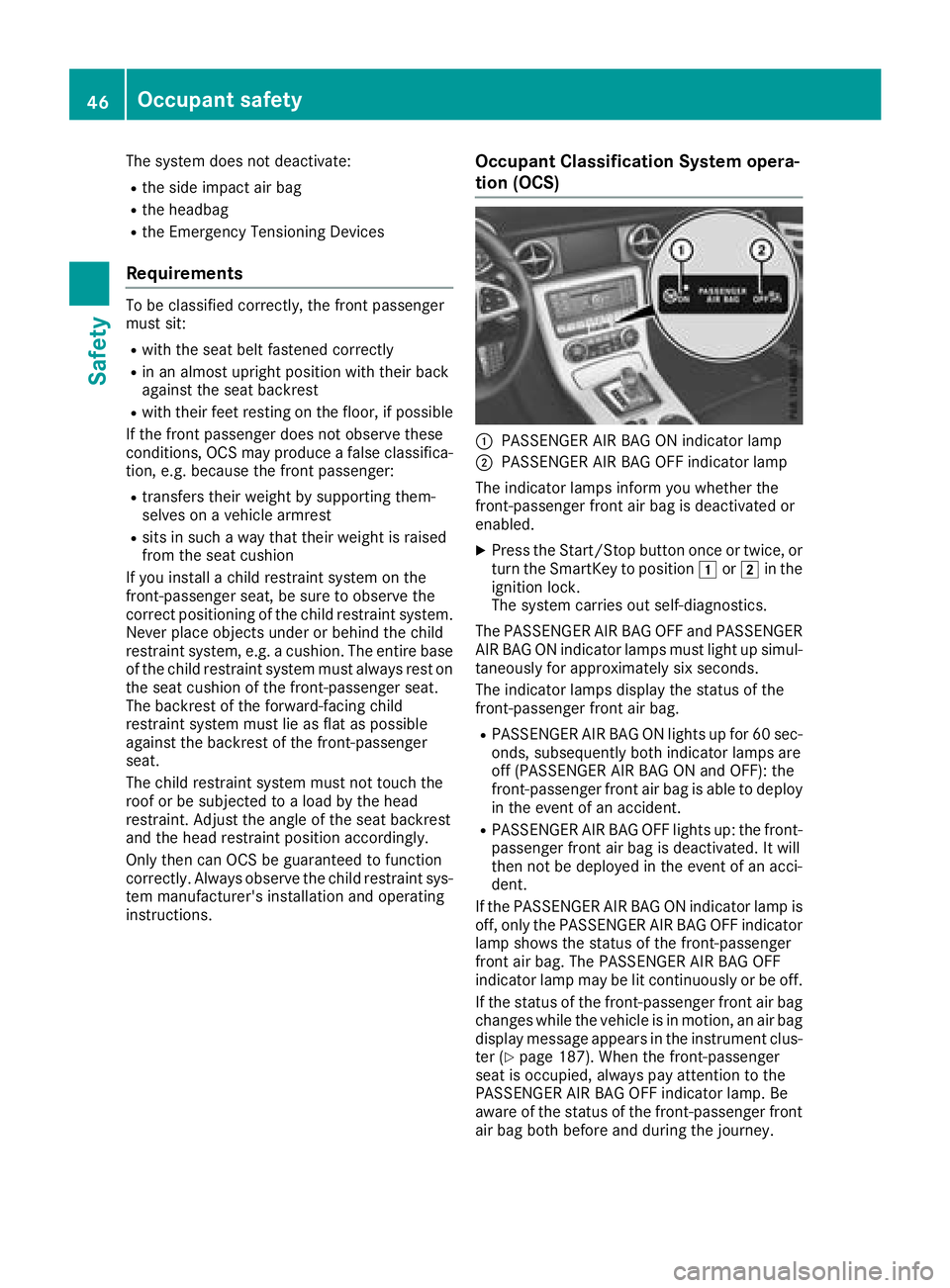
The system does not deactivate:
Rthe side impact air bag
Rthe headbag
Rthe Emergency TensioningDevices
Requirements
To be classified correctly, the front passenger
must sit:
Rwith the seat belt fastened correctly
Rin an almost upright position with their back
against the seat backrest
Rwith their feet restin gonthe floor, if possible
If the front passenger does not observe these
conditions, OCS may produce afalse classifica-
tion, e.g. because the front passenger:
Rtransfers their weight by supporting them-
selves on avehicle armrest
Rsits in such away that their weight is raised
from the seat cushion
If you install achild restraint system on the
front-passenger seat, be sure to observe the
correctp ositioningofthe child restraint system.
Never place object sunder or behind the child
restraint system, e.g. acushion. The entir ebase
of the child restraint system must alwaysr est on
the seat cushion of the front-passenger seat.
The backrest of the forward-facing child
restraint system must lie as flat as possible
against the backrest of the front-passenger
seat.
The child restraint system must not touch the
roof or be subjected to aload by the head
restraint. Adjust the angle of the seat backrest
and the head restraint position accordingly.
Only then can OCS be guaranteed to function
correctly. Always observe the child restraint sys-
tem manufacturer's installation and operating
instructions.
Occupant Classification System opera-
tion (OCS)
:PASSENGER AIR BAG ON indicator lamp
;PASSENGER AIR BAG OFF indicator lamp
The indicator lamps inform you whether the
front-passenger front air bag is deactivated or
enabled.
XPress the Start/Stop button once or twice, or
turn the SmartKey to position 1or2 in the
ignition lock.
The system carries out self-diagnostics.
The PASSENGER AIR BAG OFF and PASSENGER AIR BAG ON indicator lamps must light up simul-
taneously for approximately six seconds.
The indicator lamps display the status of the
front-passenger front air bag.
RPASSENGER AIR BAG ON lights up for 60 sec-
onds, subsequently both indicator lamps are
off (PASSENGER AIR BAG ON and OFF): the
front-passenger front air bag is able to deploy
in the event of an accident.
RPASSENGER AIR BAG OFF lights up: the front-
passenger front air bag is deactivated. It will
then not be deployed in the event of an acci-
dent.
If the PASSENGER AIR BAG ON indicator lamp is
off, only the PASSENGER AIR BAG OFF indicator lamp shows the status of the front-passenger
front air bag. The PASSENGER AIR BAG OFF
indicator lamp may be lit continuously or be off.
If the status of the front-passenger front air bag
changes while the vehicle is in motion,ana ir bag
display message appears in the instrument clus-
ter (
Ypage 187). When the front-passenger
seat is occupied, alwaysp ay attention to the
PASSENGER AIR BAG OFF indicator lamp. Be
aware of the status of the front-passenger front air bag both before and during the journey.
46Occupant safety
Safety
Page 49 of 298
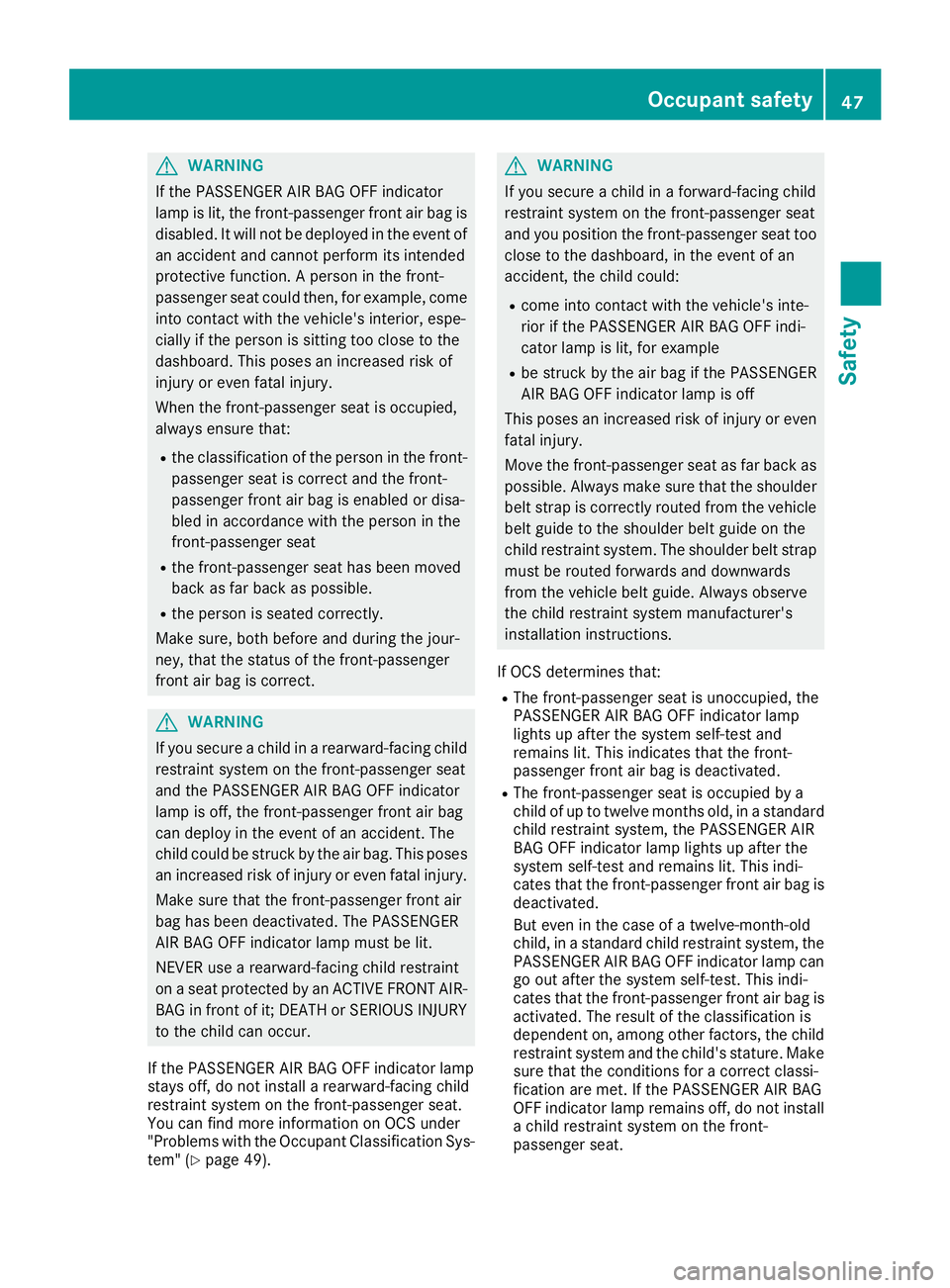
GWARNING
If the PASSENGER AIR BAG OFF indicator
lamp is lit, the front-passenge rfront air bag is
disabled. It wil lnot be deploye dinthe event of
an accident and cannot perform its intended
protective function. Apersonint he front-
passenger seat coul dthen, for example, come
into contact with the vehicle's interior, espe-
cially if the personiss itting too close to the
dashboard. This posesani ncreased risk of
injury or even fatal injury.
When the front-passenge rseat is occupied,
alway sensure that:
Rthe classification of the personint he front-
passenger seat is correct and the front-
passenger front air bag is enabled or disa-
bledina ccordance with the personint he
front-passenge rseat
Rthe front-passenge rseat has been moved
back as far back as possible.
Rthe personiss eated correctly.
Make sure ,both before and during the jour-
ney, that the status of the front-passenger
front air bag is correct.
GWARNING
If you secure achild in arearward-facing child
restraint system on the front-passenge rseat
and the PASSENGER AIR BAG OFF indicator
lamp is off, the front-passenge rfront air bag
can deploy in the event of an accident. The
child coul dbestruck by the air bag .This poses
an increased risk of injury or even fatal injury.
Make sure that the front-passenge rfront air
bag has been deactivated. The PASSENGER
AIR BAG OFF indicator lamp must be lit.
NEVER use arearward-facing child restraint
on aseat protected by an ACTIVE FRONT AIR-
BAG in front of it; DEATH or SERIOUS INJURY
to the child can occur.
If the PASSENGER AIR BAG OFF indicator lamp
stays off, do not instal larearward-facing child
restraint system on the front-passenge rseat.
You can find more information on OCS under
"Problems with the Occupant Classification Sys-
tem" (
Ypage4 9).
GWARNING
If you secure achild in aforward-facing child
restraint system on the front-passenge rseat
and you position the front-passenge rseat too
close to the dashboard, in the event of an
accident, the child could:
Rcome into contact with the vehicle's inte-
rior if the PASSENGER AIR BAG OFF indi-
cator lamp is lit, for example
Rbe struck by the air bag if the PASSENGER
AIR BAG OFF indicator lamp is off
This poses an increased risk of injury or even fatal injury.
Move the front-passenge rseat as far back as
possible.A lways make sure that the shoulder
belts trap is correctly routed from the vehicle
beltg uide to the shoulderb eltguide on the
child restraint system. The shoulderb eltstrap
must be routed forwards and downwards
from the vehicleb eltguide. Always observe
the child restraint system manufacturer's
installation instructions.
If OCS determines that:
RThe front-passenge rseat is unoccupied,t he
PASSENGER AIR BAG OFF indicator lamp
lights up after the system self-test and
remains lit. This indicates that the front-
passenger front air bag is deactivated.
RThe front-passenge rseat is occupied by a
child of up to twelve months old, in astandard
child restraint system, the PASSENGER AIR
BAG OFF indicator lamp lights up after the
system self-test and remains lit. This indi-
cates that the front-passenge rfront air bag is
deactivated.
But even in the case of atwelve-month-old
child ,inas tandard child restraint system, the
PASSENGER AIR BAG OFF indicator lamp can
go out after the system self-test. This indi-
cates that the front-passenge rfront air bag is
activated. The result of the classification is
dependent on, among other factors, the child
restraint system and the child's stature. Make
sure that the conditions for acorrect classi-
ficatio nare met. If the PASSENGER AIR BAG
OFF indicator lamp remains off, do not install
ac hild restraint system on the front-
pa
ssenger seat.
Occupant safety47
Safety
Z
Page 52 of 298
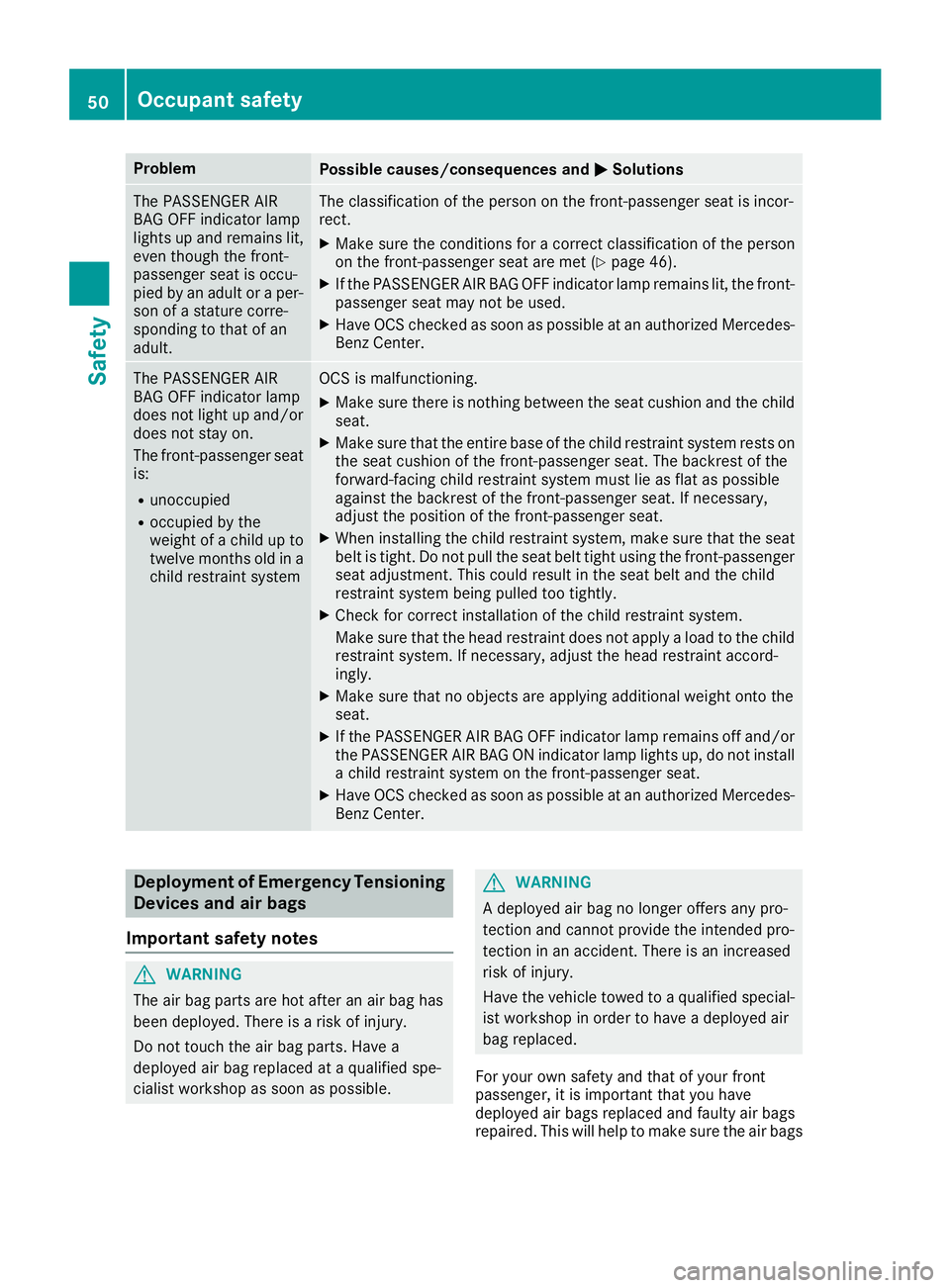
ProblemPossible causes/consequences andMSolutions
The PASSENGER AIR
BAG OFF indicator lamp
lights up and remains lit,
even though the front-
passenger seat is occu-
pied by an adult oraper-
son of astature corre-
sponding to that of an
adult.The classification of the person on the front-passenger seat is incor-
rect.
XMake sure the conditionsf orac orrect classification of the person
on the front-passenger seat are met (Ypage 46).
XIf the PASSENGER AIR BAG OFF indicator lamp remains lit, the front-
passenger seat may not be used.
XHave OCS checked as soon as possible at an authorized Mercedes- Benz Center.
The PASSENGER AIR
BAG OFF indicator lamp
does not light up and/or
does not stay on.
The front-passenger seat
is:
Runoccupied
Roccupied by the
weight of achild up to
twelve months old in a
child restraint system
OCS is malfunctioning.
XMake sure there is nothin gbetween the seat cushion and the child
seat.
XMake sure that the entire base of the child restraint system rests on
the seat cushion of the front-passenger seat. The backrest of the
forward-facing child restraint system must lie as flat as possible
against the backrest of the front-passenger seat. If necessary,
adjust the position of the front-passenger seat.
XWhen installing the child restraint system, make sure that the seat belt is tight. Do not pull the seat belt tight using the front-passenger
seat adjustment .This could result in the seat belt and the child
restraint system being pulled too tightly.
XCheck for correct installation of the child restraint system.
Make sure that the head restraint does not apply aload to the child
restraint system. If necessary, adjust the head restraint accord-
ingly.
XMake sure that no object sare applying additional weight onto the
seat.
XIf the PASSENGER AIR BAG OFF indicator lamp remains off and/or
the PASSENGER AIR BAG ON indicator lamp lights up, do not install ac hild restraint system on the front-passenger seat.
XHave OCS checked as soon as possible at an authorized Mercedes-
Benz Center.
Deployment of Emergency Tensioning
Devices and air bags
Important safety notes
GWARNING
The air bag parts are hot after an air bag has
been deployed. There is arisk of injury.
Do not touch the air bag parts. Have a
deployeda ir bag replaced at aqualified spe-
cialist workshop as soon as possible.
GWARNING
Ad eployeda ir bag no longer offers any pro-
tection and cannot provide the intended pro-
tection in an accident. There is an increased
risk of injury.
Have the vehicle towed to aqualified special-
ist workshop in order to have adeployeda ir
bag replaced.
For your own safety and that of your front
passenger, it is important that you have
deployeda ir bags replaced and faulty air bags
repaired. This will help to make sure the air bags
50Occupant safety
Safety
Page 54 of 298
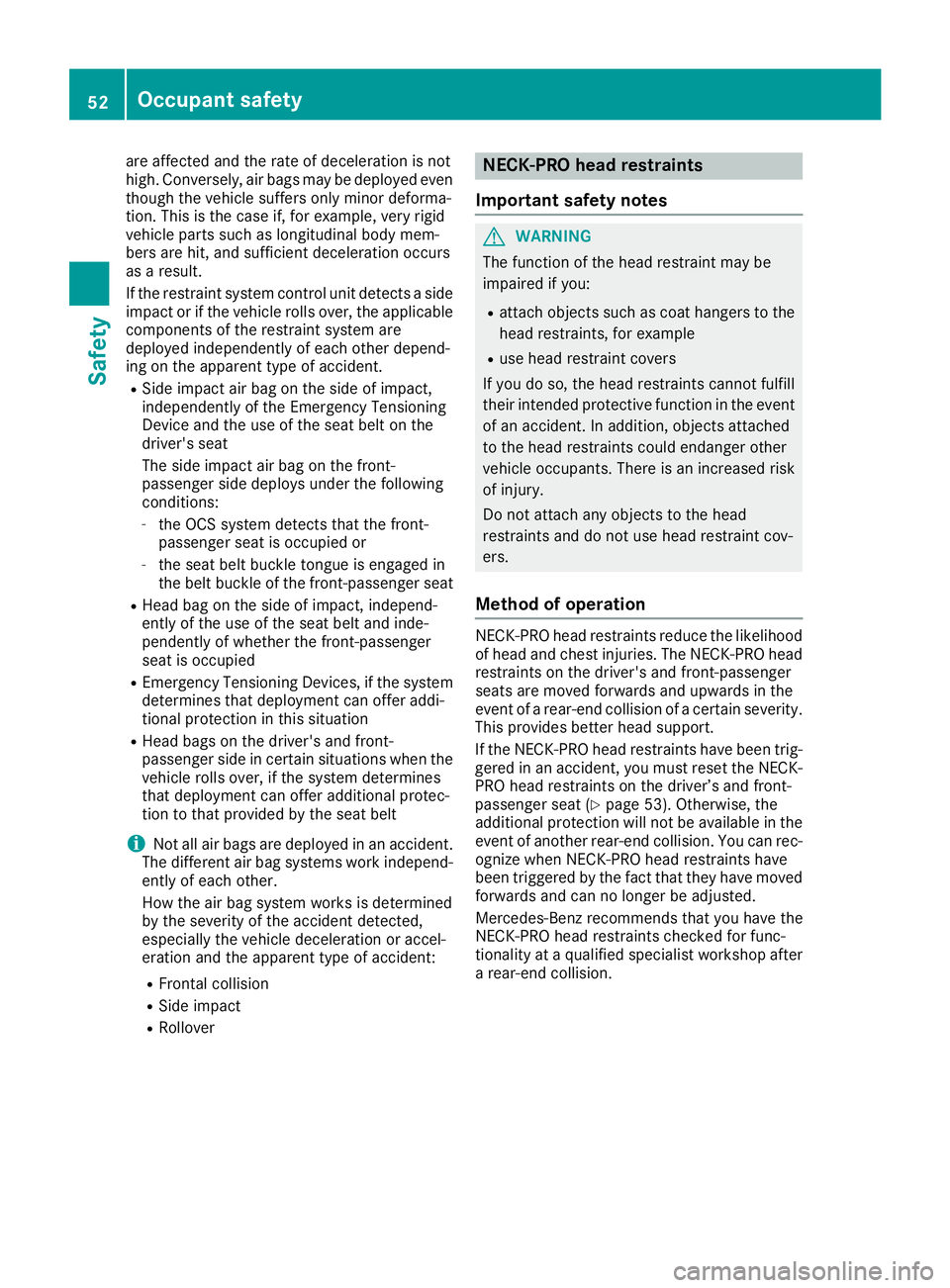
are affected and therateofd eceleratio nisnot
high.C onversely, air bags may be deployed even
though th evehicle suffers only minor deforma-
tion. This is th ecasei f, for example, ver yrigid
vehicle part ssuchasl ongitudinal body mem-
bers are hit,a nd sufficient deceleratio noccurs
as aresult.
If th erestraint system control unit detect saside
impac torift hevehicle roll sover, th eapplicable
component softherestraint system are
deployed independently of each other depend-
ing on th eapparent type of accident.
RSid eimpacta ir bag on th eside of impact,
independently of th eEme rgenc yTensioning
Devic eand th euse of th eseat belt on the
driver'ss eat
The side impac tair bag on th efront -
passenger side deploys unde rthe following
conditions:
-th eO CS system detect sthatthe front-
passenger seat is occupied or
-th es eat belt buckle tongue is engaged in
th eb elt buckle of th efront-pa ssenger seat
RHead bag on th eside of impact, independ-
ently of th euse of th eseat belt and inde-
pendently of whether th efront-pa ssenger
seat is occupied
REmergenc yTensioning Devices, if th esystem
determine sthatd eploymen tcan offer addi-
tional protection in this situation
RHead bags on th edriver'sa nd front-
passenger side in certain situations when the
vehicle roll sover, if t
h
esystem determines
that deploymen tcan offer additional protec-
tio ntot hatp rovided by th eseat belt
iNot all air bags are deployed in an accident.
The differenta ir bag systems work independ-
ently of each other.
How th eair bag system worksisd etermined
by th eseverityoft heaccidentd etected,
especially th evehicle deceleratio noraccel-
eration and th eapparent type of accident:
RFrontal collision
RSid eimpact
RRollover
NECK-PROh eadr estraints
Important safety notes
GWARNING
The function of th ehead restraint may be
impaired if you:
Rattach object ssuchasc oat hangerstot he
head restraints, for example
Ruse head restraint covers
If you do so, th ehead restraint scanno tfulfill
their intended protective function in th eevent
of an accident. In addition,o bjectsattached
to th ehead restraint scoul de ndanger other
vehicle occupants. Thereisani ncreased risk
of injury.
Do no tattach any object stothehead
restraint sand do no tuse head restraint cov-
ers.
Method of operation
NECK-PRO head restraint sreduc ethe likelihood
of head and chest injuries.T he NECK-PRO head
restraint sonthedriver'sa nd front-passenger
seatsa re moved forwards and upwards in the
eventofar ear-endcollision of acertain severity.
This provides bette rhead support.
If th eNECK-PRO head restraint shave been trig-
gered in an accident, you must reset th eNECK-
PRO head restraint sonthedriver’s and front-
passenger seat (
Ypage 53) .Otherwise, the
additional protection will no tbeavailabl einthe
eventofa nother rear-en dcollision.Y ou can rec-
ognize when NECK-PRO head restraint shave
been triggered by th efacttha tthe yh ave moved
forwards and can no longer be adjusted.
Mercedes-Ben zrecommend sthaty ou have the
NECK-PRO head restraint schecked for func-
tionalit yataq ualified specialist workshop after
ar ear-en dcollision.
52Occupant safety
Safety